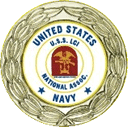By Dominick Maurone LCI(G) 440
A few days after the Landings at Normandy France the United States Navy along with Marine and Army Divisions launched Operation Forager on the other side of the world. Their goal was to take the Marianas Islands from the Japanese. It was on a much smaller scale than Operation Neptune “only” deploying 535 ships, 125,000 sailors and Marines plus the Army’s 27th Infantry Division. After the painful lessons learned during the landings at Tarawa, the Marine Corp adopted the fire support provided by the LCI rocket and gunships as an integral part of their amphibious landings in the Pacific. This is one of their stories:
In May 1944, we gathered in the Marshall Islands in preparation for the invasion of the Marianas Islands. We were in a convoy that consisted of Tractor Group-Four. Our flag ship was the USS Black, DD 666. We had sixteen LSTs, carrying the First Provisional Marine Brigade, which was a unit of the famous Carlson’s Raiders. Our Group Eight consisted of nine LCIs, 365, 366, 439, 440, 442,474, 475, 437, and 450.
On 10 May, we were under way. We participated on the initial assault on Saipan Island on 15 June, and stayed in the area until 5 July. After participating in the landings we went along with TG-4 as an aircraft screen. We were attacked by five Jap torpedo planes, some of which launched their torpedoes at the USS Black. One of the planes was shot down and crashed about five hundred yards off our starboard beam. For the next few weeks we patrolled between Saipan and Guam.
We left Saipan on 5 July 1944, and headed for Eniwetok, where we picked up supplies-ammo, water, mail–and reloaded our rocket crates. We then joined a convoy and were on our way for the invasion of Guam. On 21 July 1944, we got into position with the rest of Group Eight to attack Agat Beach. We headed towards the island at five knots. At 0820 we fired our test rockets to see how close to the beach they would hit. Then we moved in closer and fired salvo after salvo until our rocket launchers were empty, which put us within a hundred yards of the beach. We then turned broadside to the beach and commenced firing with our 40-mm and 20-mm guns, and our .50-caliber water-cooled machine guns. That continued until our troops established a beachhead, at which time we pulled away from the island.
We were then ordered, along with other LCIs in Group Eight, to patrol the boat lanes between Bangi Point and Neye Island. Division 15 Commander, aboard LCI 365, then ordered us to line up parallel to each other, 120 feet apart. While we were in this formation the 365 got caught in a crossfire between the Jap guns south of Bangi Point and from the north at Palagi Rock and Neye Island. The 365 received nine hits on both port and starboard sides, killing seven and wounding fifteen. The 365 was out of action and the 439 became our flagship, and for the next couple of days we continued to patrol the boat lanes.
Two days after the 365 was hit, a small unit of Marines in their amphibious vehicles entered the water off of Agat Beach and headed north through the boat lanes in front of the LCIs. They turned into a small beach in the area between Neye Island and Palagi Rock, the same area where the Japs hit the 365. A burst of machine gun and mortar fire destroyed their vehicles and all the Marines were killed. We were then given orders by the commander to go in and draw their fire. This was so our planes could see where the firing was coming from and destroy the site. This was definitely a suicide mission. The division commander, now aboard the 439, ordered the single file method for strafing the area between Neye Island and Palagi Rock. There were seven LCIs on this mission, and we were perfect targets for the Japs. As we proceeded in at slow speed, we saw the 439 get hit with mortar fire. She suffered two killed and thirteen injured. As the 366 reached its point of fire, it was also hit, with five killed and thirteen wounded, including the Commanding Officer. We, on the 440, were next in line. Our commander, Lt. Keyes, saw where the Jap mortar shells were falling and turned to star-board and out of their range. Our planes were then able to see where the mortar fire was coming from and destroyed the site.
Reprinted from ELSIE ITEM 71

